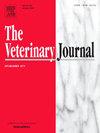一种犬牙周炎家庭筛检工具的研制。
IF 3.1
2区 农林科学
Q1 VETERINARY SCIENCES
引用次数: 0
摘要
牙周病是狗的常见病,但经常被主人忽视。本研究的目的是开发和验证一种基于龈上菌斑细菌生物标志物鉴定的犬牙周炎家庭筛查工具。进行了一系列的研究,以建立收集牙菌斑和稳定其细菌谱的方法。主人使用这些方法在家庭环境中从他们的狗(n=127)收集牙龈上菌斑样本,这些狗的牙周健康状况已由兽医确定。使用定量聚合酶链反应(qPCR)对样本进行牙周炎细菌生物标志物的筛选。对用于菌斑收集的6个拭子(每个拭子10个样本)的评估表明,使用通用细菌qPCR测定,CytoSoft™细胞学刷产生的细菌DNA量最高。对六种稳定方法(每种10-11个样品)的评估显示,在环境温度下储存的风干拭子与在-80℃下保存5天的拭子之间没有显著差异。主人收集的斑块样本的qPCR数据表明,预测疾病的准确性为80.9%,特异性为80.0%,敏感性为80.9%。狗主人使用CytoSoft™细胞学刷收集龈上菌斑并邮寄到实验室进行qPCR分析是一种实用的犬牙周炎筛查方法。简单,成本效益的方法是一个可行的建议,使检测牙周炎的客户拥有的狗最终改善他们的口腔健康和生活质量。本文章由计算机程序翻译,如有差异,请以英文原文为准。
Development of an in-home screening tool for canine periodontitis
Periodontal disease is a common condition in dogs but frequently goes unnoticed by owners. The objective of this study was to develop and validate an in-home screening tool for the detection of canine periodontitis based on the identification of bacterial biomarkers in supragingival plaque. A series of studies were undertaken to establish methods for collecting dental plaque and stabilising its bacterial profile. These were used by owners to collect supragingival plaque samples in a home setting from their dogs (n = 127) whose periodontal health state had been determined by a veterinarian. Samples were screened for the presence of a bacterial biomarker of periodontitis using quantitative polymerase chain reaction (qPCR). Evaluation of six swabs (10 samples each) for plaque collection indicated the CytoSoft™ cytology brush yielded the highest amount of bacterial DNA, determined using a universal bacterial qPCR assay. Evaluation of six stabilisation methods (10–11 samples each) showed no significant differences between air-dried swabs stored at ambient temperatures and those maintained at −80°C for 5 days. qPCR data from plaque samples collected by owners indicated an accuracy at predicting disease of 80.9 %, a specificity of 80.0 % and a sensitivity of 80.9 %. Collection of supragingival plaque by dog owners using the CytoSoft™ cytology brush and postage to a laboratory for qPCR analysis is a practical method of screening for canine periodontitis. The simple, cost-effective method is a viable proposition to enable the detection of periodontitis in client-owned dogs ultimately improving their oral health and quality of life.
求助全文
通过发布文献求助,成功后即可免费获取论文全文。
去求助
来源期刊

Veterinary journal
农林科学-兽医学
CiteScore
4.10
自引率
4.50%
发文量
79
审稿时长
40 days
期刊介绍:
The Veterinary Journal (established 1875) publishes worldwide contributions on all aspects of veterinary science and its related subjects. It provides regular book reviews and a short communications section. The journal regularly commissions topical reviews and commentaries on features of major importance. Research areas include infectious diseases, applied biochemistry, parasitology, endocrinology, microbiology, immunology, pathology, pharmacology, physiology, molecular biology, immunogenetics, surgery, ophthalmology, dermatology and oncology.
 求助内容:
求助内容: 应助结果提醒方式:
应助结果提醒方式:


